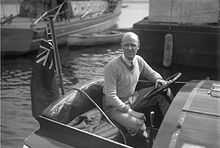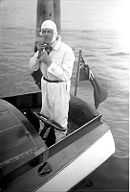Henry Segrave
| Sir Henry O'Neil de Hane Segrave | |
|---|---|
|
Segrave at the 1921 French Grand Prix | |
| Born |
22 September 1896 Baltimore, Maryland |
| Died |
13 June 1930 (aged 33) (lake) Windermere, Cumbria, England |
Cause of death | crash during water speed record attempt |
| Nationality | British |
| Education | Bilton Grange then Eton College |
| Occupation | Speed record holder |
Sir Henry O'Neil de Hane Segrave (22 September 1896 – 13 June 1930) was famous for setting three land speed records and the water speed record. He was the first person to hold both the land and water speed records simultaneously. He was the first person to travel at over 200 mph (320 km/h) in a land vehicle. The Segrave Trophy was established in 1930 to commemorate his life.
First World War
A British national, Segrave was born on 22 September 1896 in Baltimore, Maryland of an American mother and an Irish father. He was raised in Ireland and attended Eton College in England. He was commissioned into the Royal Warwickshire Regiment in 1914 and served as a fighter pilot with the Royal Flying Corps from January 1916 (although he retained his commission in the Royal Warwickshire Regiment). He was wounded twice, in 1915 and 1916. In July 1916 he became a flight commander as a temporary captain. In 1919 he transferred to the Royal Air Force Administrative Branch, but soon resigned his commission due to his wounds. Segrave bragged that he would drive a car at over 200 miles per hour (320 km/h).
Motor racing career
In 1921 the 200-Mile Race at Brooklands was organised by the Junior Car Club, the first long-distance race to be run in Britain. The race, a contest for 1,500 c.c. light cars, was won by Segrave in a Talbot-Darracq.[1]
He was the first Briton to win a Grand Prix in a British car. He won the 1923 French Grand Prix and the 1924 San Sebastian Grand Prix at Circuito Lasarte (Spain) in a Sunbeam automobile. After a further win at Miramas in France, he retired from racing to concentrate on speed records.
Land speed record
On 21 March 1926, he set his first land speed record in his 4-litre Sunbeam Tiger Ladybird on the sands at Southport, England at 152.33 mph (245.149 km/h). This record lasted for just over a month, until broken by J.G. Parry-Thomas driving Babs
He regained the land speed record in 29 March 1927 in his 1000 HP Sunbeam Mystery (also known as 'the Slug') at the Daytona Beach Road Course at 203.79 mph (327.97 km/h), becoming the first person to travel over 200 mph (320 km/h).
Segrave set his final land speed record at 231.45 mph (372.46 km/h) in his new car, the beautiful Golden Arrow, at Daytona Beach on 11 March 1929. This car had only 18.74 miles (30.16 km) on it, which is the least used car to set the record. After being the first person on the scene of Lee Bible's death, Segrave began concentrating on the water speed record. Golden Arrow has never been used since. The Golden Arrow is on display along with the Sunbeam 350HP and the Sunbeam 1000HP at the National Motor Museum, Beaulieu.
Water speed record and death


Segrave was also an avid motorboat racer.
After his 1929 land speed record, he immediately went to Miami for a motorboat race against Garfield Wood, multiple water speed record holder and the first man to travel over 100 miles per hour on water. Segrave won, causing Wood's first defeat in nine years. After Segrave returned to Great Britain, he was knighted for his many accomplishments.
A few months after receiving his knighthood, on Friday 13 June 1930, Sir Henry Segrave unknowingly captured the water speed record driving Miss England II on England's largest natural lake, Windermere. In a follow-up run the boat presumably hit a log and capsized, killing Miss England's mechanic, Victor Halliwell. Segrave's unconscious body was recovered, and taken to a hospital. He regained consciousness for a moment, was informed that he had indeed broken the record, then died a few moments later of lung haemorrhages.
Kaye Don subsequently broke two more world water speed records in Miss England II.
Aircraft designer
When Segrave's interest in flying returned in the late 1920s he designed an aircraft for luxury touring. The aircraft was a wooden twin-engined monoplane built as the Saro Segrave Meteor, three metal versions being built as the Blackburn Segrave.[2]
Publications
Henry Segrave (1928). The Lure of Speed.
References
- ↑ The Manchester Guardian, 24 October 1921, Page 3; The Times of India, 16 November 1921, Page A4.
- ↑ Jackson, A.J. (1974). British Civil Aircraft since 1919. London: Putnam. ISBN 0-370-10014-X.
External links
| Wikimedia Commons has media related to Henry Segrave. |
- Biography
- Biography at the Brooklands Society
- Speed machines at Channel4.com (down a little)
- Reprinted from Speedboat Kings: 25 Years of International Speedboating by J. Lee Barrett (Detroit: Arnold-Powers, Inc., 1939), Ch.11
- Encyclopædia Britannica article
| ||||||||||||||||||
| ||||||||||||||||||||||||
|
.jpg)
